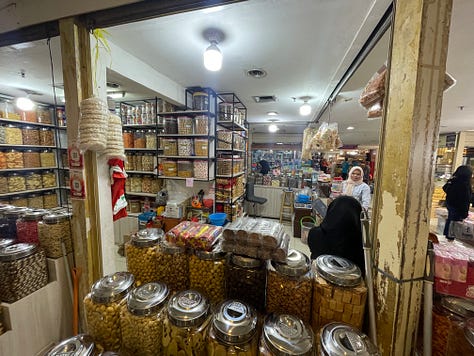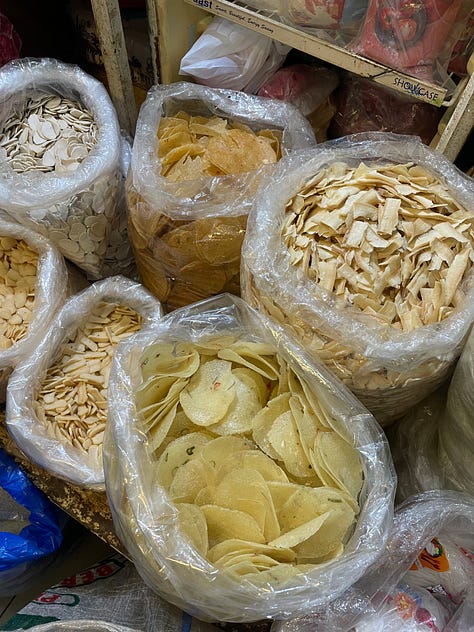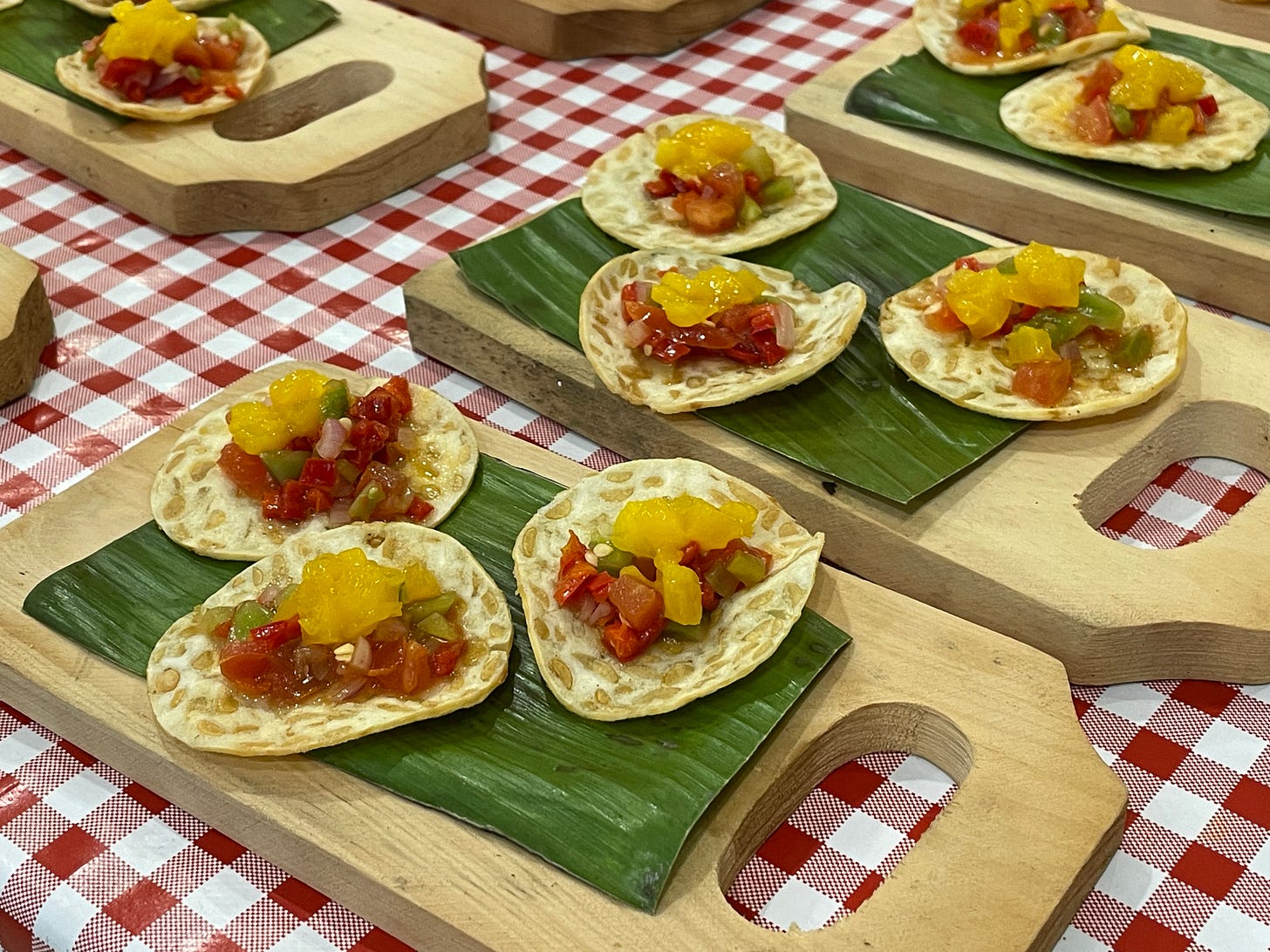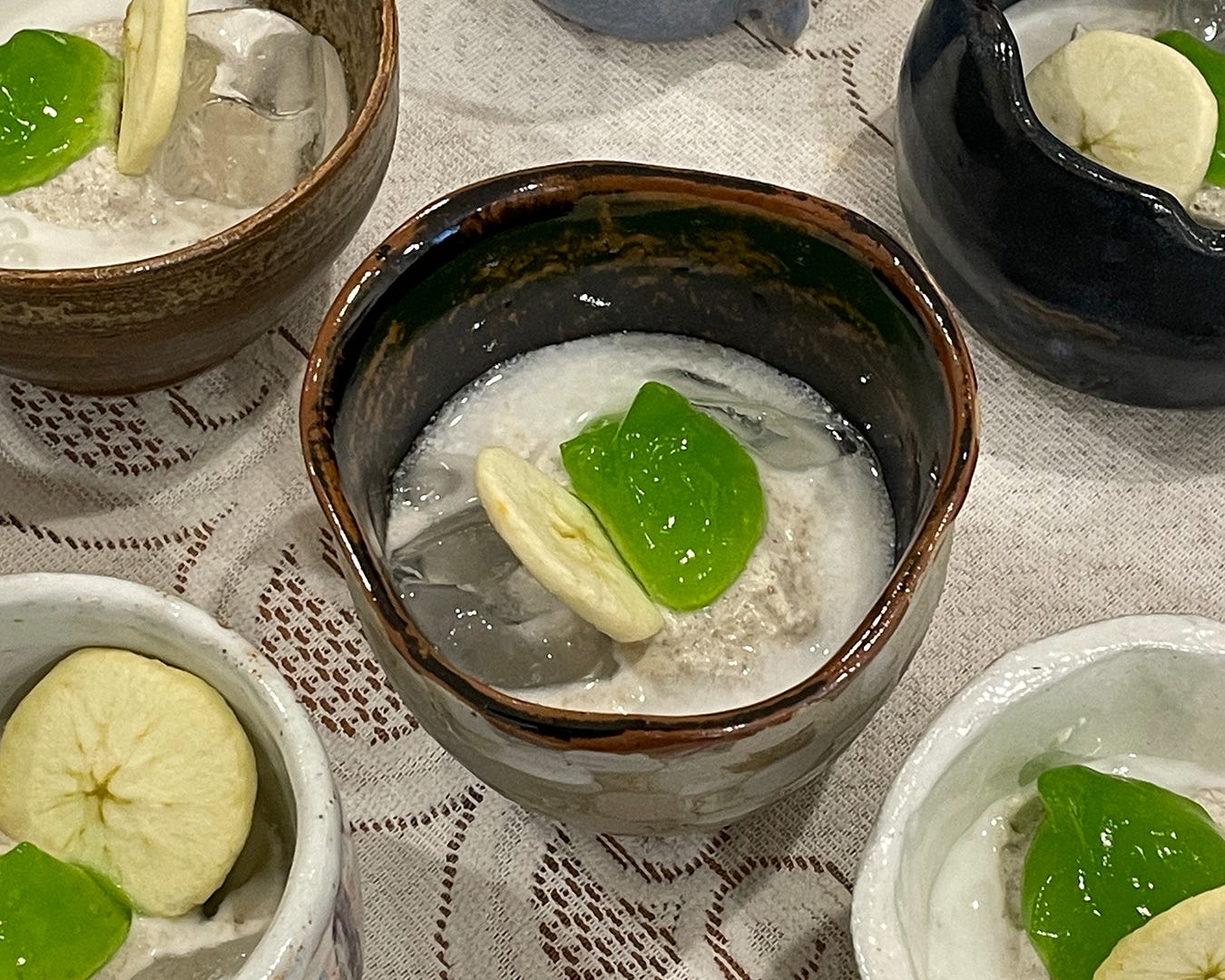Halo there, happy Monday! Fabi here, writing to you from Jakarta Selatan.
Welcome to Kepayang! If this is the first time you’re here, I’m the writer behind this space. I write essays on food, culture, and sustainability every two weeks. Or at least, that’s the aim. But other than that, Kepayang has also grown into a vibrant community for food enthusiasts and anyone who loves a good food chat. So stick around!
Today’s newsletter is me, mansplaining how the humble kerupuk (crackers) is actually a genius food habit we’ve got here in Indonesia. It’s not just about bold flavours — we also crave that loud, satisfying crunch. Some might write off kerupuk as old-fashioned or basic, but after my last community hangout, where I served a three-course meal featuring kerupuk, I can confidently say that reimagining it on your plate can totally transform your eating experience into something fun and playful. Enjoy the read!
Kepayang is free for now, so any engagements mean so much to support the platform’s growth. You can subscribe to get the newsletter sent directly to your email, like, comment, and share if you resonate with what I write.
Alternatively, you can buy me a coffee through my PayPal here: https://paypal.me/chalafabia - or if you’re based in Indonesia, you can send your donation through QRIS here (under the name Tamanan). Any amounts are welcomed and will directly contribute to sustaining this platform to cover expenses related to operations, research, writing, and marketing. ☕️
A couple of weeks ago, I went on a five-day trip to Jawa Timur with my family. When they suggested the idea, I said yes without hesitation. For them, the trip was mainly about attending my cousin's wedding in Trenggalek. For me, it was the perfect excuse to visit where my family came from and try all the amazing food in Surabaya, Malang, and Madiun.
One of my favourite Jawa Timur dishes has to be sego pecel. Sego means rice in Javanese, and pecel is a mix of blanched vegetables drenched in a savoury, slightly spicy peanut sauce. The peanut sauce where I live (Jakarta) tends to be diluted and unnecessarily spicy. But in Jawa Timur, the sauce is built different. It’s nutty, warm, sweeter, and aromatic - thanks to the kencur (aromatic ginger).
Jawa Timur itself is a massive province that covers nearly 48,000 square kilometres – larger than Denmark and almost the same size as Switzerland. With a region this big, of course, there’s going to be variety in how sego pecel is served.
For example, in Madiun, where Ibu (my mom) is from, sego pecel is usually served with kerupuk gendar – a rice cracker made from seasoned leftover cooked rice. Meanwhile, in Malang, where Bapak (my dad) is from, it’s paired with rempeyek kacang – a thin, crispy cracker made from rice flour, spices, and peanuts.


Why Kerupuk is Important.
The role of kerupuk in sego pecel is clear. With the white rice and blanched veggies being super soft, the crunch of kerupuk is like a breath of fresh air, making the whole dish way more exciting to eat.
The International Journal of Food Science (2024) also agrees that texture is a huge deal when it comes to what we enjoy eating. Creamy textures like yoghurt are tied to positive emotions and feeling good, while crunchy snacks like chips or crackers bring the fun and satisfaction. Mixing up textures keeps things interesting, and eating the same texture the whole time would be boring as hell.
In Indonesia, some form of crunch, be it kerupuk or keripik — gets thrown into almost every dish you can think of. Bubur ayam (chicken porridge) may come with kerupuk udang (shrimp crackers). A nasi goreng (fried rice) without a kerupuk bawang (garlic crackers)? Absolute crime. And if you come to a Rumah Makan Padang (A type of restaurant selling traditional Minang food), you can order the not-so-secret “secret menu”: rambak (cattle skin crackers) soaked in a rich gulai sauce.
💡 Kerupuk refers to crackers that are made by mixing flour and seasoning and turning them into dough before frying. Keripik usually features an ingredient in its original form, they’re minimally seasoned or left plain.
The options are pretty much endless. So, after my trip to Jawa Timur, I decided to swing by Pasar Mayestik to see what they had in store.
Visiting a pasar (lit. traditional wet market) was a no-brainer. It’s one of those places that has stood the test of time. Plus, since it’s close to where many people live, it gives us a glimpse of what’s most accessible and reflects what the majority consumes.
I navigated through the aisles of clothes and dress sellers on the first floor to reach the stairs that took us straight to the lower ground. The lower ground is home to sellers offering packaging for bakeries, restaurants, and caterers. Some also sell bulk snacks, or curah in Bahasa Indonesia. Long before those shiny eco-bulk stores started greenwashing the way we buy things we don’t need, these curah stores were already doing their thing — simple and straight to the point.
From there, we went down another floor to what I’d call a basement. A section of this floor is dedicated to dried goods like flour, beans, and, the main reason we came: kerupuk and keripik.



We easily found more than ten types of kerupuk and keripik. Some were ready to eat, meaning they had already been fried — like keripik tempe (tempeh chips) and kerupuk ikan (fish crackers). Others were in their dried form, like kerupuk bawang, opak (cassava crackers, and emping (melinjo crackers). Personally, I prefer the dried ones because they’re more affordable and have a longer shelf life.
Despite their bold flavors and textures, kerupuk actually embodies humility.
On their own, kerupuk could easily be the star of the show – but they choose not to be. With their punchy flavours, often loaded with salt, MSG, and seasonings, they make for a pretty damn good snack. And let’s not forget that addictive crunch.
But, like anything bold in flavour, too much of it can quickly become overwhelming. Kerupuk seems to understand this about themselves, fully owning the fact that their real strength lies in complementing and enhancing other dishes rather than standing solo.
To showcase the range and versatility of this iconic Indonesian crunch, I developed a three-course lunch for my last Community Hangout.
First course: Dabu-dabu with Keripik Tempe
Dabu-dabu is a type of sambal (condiment) popular across Sulawesi in Eastern Indonesia. Traditionally, it’s made with chopped tomatoes (both red and green), shallots, large red chillies (not spicy), bird’s eye chillies (spicy), and lime juice. The magic happens when these raw ingredients are tossed in scalding-hot coconut oil, just enough to tenderise them and mellow out their sharpness. It’s giving salsa, but it is not salsa, and I refuse to call it that.
For the twist on this classic dish, we added diced mango and served it with keripik tempe. Mango season in Indonesia started back in August, and we’re still swimming in its abundance through early November. The Dabu-dabu itself is spicy, tangy, and savoury, thanks to the natural MSG in tomatoes.
The addition of mango brings a sweet, fruity note that perfectly balances the heat and acidity. And since the Dabu-dabu has a soft, slightly mushy texture, it only makes sense to pair it with the crunch of keripik tempe. Honestly, a super-slay appetiser to get your taste buds ready for what’s coming next.
Second course: Nasi Goreng Kepayang
It’s impossible to talk about kerupuk without mentioning nasi goreng. In fact, in Indonesia, it’s practically a crime to serve nasi goreng without kerupuk (source: trust me). We even have a habit of taking the first scoop of our nasi goreng with kerupuk instead of a spoon.
One of the most classic types of nasi goreng you’ll find at a typical Indonesian restaurant is the one made with kecap manis (sweet soy sauce). But since this was my first time cooking nasi goreng for my community, I decided to take an experimental route and feature a star ingredient: kepayang.
Yes, you heard that right – kepayang (Pangium edule) is an actual ingredient! It’s a seed commonly grown in East Java, also known as kluwak. Traditionally, it’s used in soupy dishes like rawon and brongkos, giving them their iconic black colour. On its own, kepayang has a rich, savoury, slightly bitter, and creamy flavour – almost like butter. Because it’s often fermented after harvesting, you can also expect a subtle funky undertone, which adds depth to its taste.
For this nasi goreng, we incorporated kepayang alongside bold spices like cumin, ginger, turmeric, and coriander. I intentionally made it less salty to balance it with the three types of kerupuk we served it with: Gendar Rumput Laut (seaweed and rice crackers), Emping, and Kerupuk Bawang. To round things out and tone down the richness, we added slices of fresh tomatoes, cucumbers, pickled shallots, and wedges of lime.
Third course: Pisang Berendam
Pisang Berendam has such a wacky name, and I absolutely love it. It literally translates to “bananas taking a bath,” and that’s exactly what the dish looks like — a banana semifreddo lounging in a pool of coconut cream. The inspiration came from a traditional dish from Simeulue called Memek. It’s essentially a mashed banana drenched in a soupy coconut cream that is topped with crunchy popped rice. It’s a popular dish that you would typically enjoy by the beach, but for this occasion, I’m turning the banana into ice cream.
It’s not exactly ice cream — it’s semifreddo, meaning “semi-frozen.” Imagine a soft, airy ice cream, almost like a mousse, that melts instantly in your mouth. This delightful semifreddo is served in a bowl of salted coconut cream and topped with a dollop of tangy pandan lime gel for a zesty kick. To keep things playful, it’s paired with three types of fruit crackers (kerupuk buah)—jackfruit, snake fruit, and apple—from Malang, East Java.
Indonesia’s kerupuk culture is as vast and diverse as its culinary heritage.
While it’s often seen as something traditional or mundane, presenting kerupuk in fun and modern ways really highlights its versatility. Whether enjoyed on their own, used as a crunchy utensil, or added to elevate a dish, kerupuk has the power to transform your entire eating experience.
Does your local cuisine have something similar? Let me know!
Other contents that I made recently:
🚦 Read about the problem behind street food vendors relocation: here.
🤔 Read about how Indonesians please others when it comes to food: here.
🎪 Read about the wacky way we Indonesians name our food: here.
🌊 Read about the sus Maluku’s seaweed industry: here
🌱 Read the news on Aceh’s recent ganja control actions: here.
🍚 Read the news on how to combat rice-dependency: here.
🔥 Read a whole ass essay on Indonesia’s hot sauce, Saus Sambal: here.
📖 Read about how recipes don’t and do matter at the same time: here
☕️ Read about the different coffee culture waves and how they are today: here.
🐈 Read my first literary review, on food representation in a short story: here.
🥤 Read this essay if you like sugary drinks: here.
🍞 Read an essay on Indonesia’s wheat dependency problem: here.
If you like today’s newsletter, please like and share it with your friends! Comment down below your thoughts and let me know if you have any other topics you want me to discuss. Until then, I’ll see you in two weeks!
Follow me everywhere:
TikTok: @berusahavegan
Kepayang’s Instagram: @readkepayang
Instagram: @menggemaskan
LinkedIn: Chalafabia Haris
Work with me: readkepayang@gmail.com










